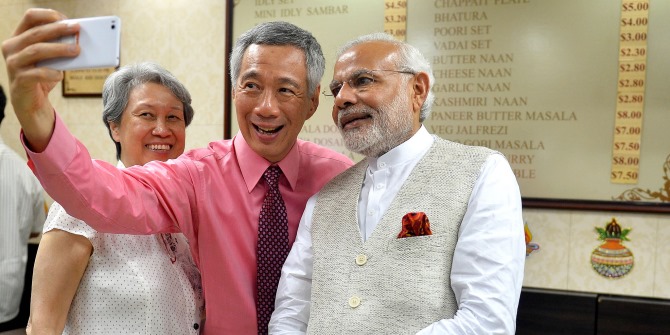As journalists, activists and protesters have come under increasing pressure over the last few years, Saloni Kapur looks at how ideas from International Relations theory can help explain how control in Indian society has changed as the country gears up for this year’s elections.
Since 2014, journalists, students and activists in India have been harassed, intimidated, arrested or even killed at an alarming rate. These deeply worrying cases have occurred at a time when power has been centralised in state hands, diluting the influence of various social actors. As India prepares for elections this year, the power of non-state actors in society and the place of dissenting voices are fundamentally at risk.
Targeting of liberal journalists
The targeting of liberal journalists is a trend that has emerged in India over the past four years. Gauri Lankesh, a Bengaluru-based journalist who was critical of Hindu nationalism and prime minister Narendra Modi, was shot dead outside her residence in September 2017. In June 2018, Kashmiri journalist Shujaat Bukhari was murdered outside his office in Srinagar, hours after he tweeted about a United Nations report on human-rights abuses in Kashmir. Rana Ayyub, an investigative reporter who wrote a book about the complicity of Modi and Bharatiya Janata Party (BJP) president Amit Shah in religious riots in Gujarat state in 2002, received gang-rape threats and was the subject of a doctored pornographic video in April 2018. Liberal newswoman Sagarika Ghose was also the target of rape threats. Another reporter, Swati Chaturvedi, writes in her book I am a Troll about how the trolling of government critics is an organised campaign of the BJP’s social-media cell.
Arrest of social activists
The arrest of social activists between June and August 2018 is an additional way in which dissent has been suppressed under the current regime. Meanwhile, in Kashmir, around 70,000 protesters have been killed in recent years in violation of the right to protest in a democracy. The suppression of student protests at the University of Hyderabad and Jawaharlal Nehru University (JNU), and the arrest of JNU student activists on charges of sedition, have been means of narrowing the intellectual space for ideas that challenge the policies and ideology of the ruling party—and, more broadly, the establishment.
Centralisation of power
Government institutions have not been exempted from these attempts to subdue opposition and centralise power in the hands of a few. The executive branch’s interference in the appointment of Supreme Court judges in April 2018 ruffled feathers within the judiciary. In October 2018, India’s central bank objected to an executive recommendation that a proposed Payments Regulatory Board be chaired by an individual appointed by the central government, and not by the central bank’s governor. Meanwhile, Prabhat Patnaik wrote in July 2018 that the government’s plan to abolish the University Grants Commission and replace it with a Higher Education Commission of India would “immensely increase political control over the academia.”
Thus, since 2014, there have been clear moves in India to centralise power in the state while diluting the influence of various social actors, including journalists, activists, students and intellectuals. In addition, the central government has sought to tighten its control over a variety of state institutions. While an independent media and judiciary and the freedom to protest are vital signs of a healthy democracy, in India, there has been a discernible trend of centralising social control.
Integrated and dispersed domination
International Relations theorist Joel Migdal differentiates between patterns of integrated and dispersed domination as a way of understanding the relationship between the state and society in a given country, and his ideas can be applied to India to understand its changing social climate.
He sees integrated domination as a condition in which the state is able to establish broad power and act coherently. Conversely, dispersed domination represents a situation wherein neither the state, nor any societal actor, is able to establish nationwide domination, resulting in the country being pulled in different directions.
Migdal’s separation of the state from society rests on the idea that the state is “a field of power marked by the use and threat of violence,” while society comprises social actors such as clans, tribes, and linguistic and ethnic groups. For Migdal, Western states tend to have patterns of integrated domination—power is centralised in the state, resulting in a strong state-weak society pattern of social control. Meanwhile, postcolonial states in Asia and Africa tend to display patterns of dispersed domination, wherein power is diffused among diverse social actors. This results in a strong society-weak state pattern of social control.
For most of its history, India has conformed to Migdal’s prediction of a postcolonial nation with a strong society-weak state pattern of social control. Power has been diffused among a variety of social actors, ranging from caste groups, religious organisations, ethnic and linguistic identity groups, and local “strongmen” to the media, diverse political organisations, activists and intellectuals. Within the state apparatus itself, power has been dispersed among the various wings of the administration, representing a strong democratic setup. However, over the past four years, under Modi’s leadership, there has been a discernible shift away from this pattern of dispersed domination to one of centralised power.
The suppression of journalists, activists and protesters; the policing of university campuses; and the consolidation of the ruling party’s power through the undermining of democratic institutions raise the possibility of a weakening of non-state actors. On the other hand, the government’s silence over the intimidation of journalists and mob violence against Muslim cow traders (until the Supreme Court intervened in July 2018) has emboldened violent social actors whose Hindu nationalist ideology aligns with the BJP’s. Thus, there has been a simultaneous undermining of liberal social actors, and invigoration of more conservative social forces under the current administration. This is a worrying a trend for a country whose vibrant diversity, culture of debate, and messy but spirited democracy have, arguably, been its biggest strengths. With general elections due in April-May 2019, it remains to be seen whether the move towards a more centralized form of control will be a lasting shift in India’s pattern of governance.
This article gives the views of the author, and not the position of the South Asia @ LSE blog, nor of the London School of Economics. Please read our comments policy before posting. Photo credit: Unsplash, Markus Spiske
Saloni Kapur is a PhD candidate in International Relations at Lancaster University. She is the co-editor of Securitisation in the Non-West, published by Routledge in 2019. @sassy_sal00







